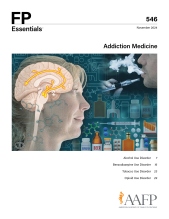
This clinical content conforms to AAFP criteria for CME.
Most overdose deaths in the United States involve opioids. Identification and management of opioid use disorder by primary care physicians is a critical need in health care. Substance use disorders share neurobiological dysregulation of the central motivation and reward pathway (powered by dopamine) that manifests as a cycle of addiction driven by impulse and compulsion. It is important that concern for opioid use disorder does not disrupt appropriate treatment of pain and that analgesic narcotic use is adequately monitored, especially in patients at risk of opioid use disorder. Most patients with opioid use disorder do not receive treatment. Those who do receive treatment will experience uncomfortable, but not life-threatening, symptoms of withdrawal. These symptoms can be managed with alpha2-adrenergic and opioid agonists that also reduce the reinforcement of drug use and help prolong recovery. The 2023 Mainstreaming Addiction Treatment Act removed the waiver requirement for buprenorphine prescribing, which closes the substantial gap in access to medication for opioid use disorder existing across gender, racial, and socioeconomic groups. Treatment plans that include medication for opioid use disorder have been shown to substantially reduce mortality.
Case 4. SK is a 25-year-old patient who was prescribed oxycontin for the first time after oral surgery 5 years ago. After the initial prescription ran out, he was denied refills from the surgeon but was able to get Vicodin from a friend. Later, he went to a pain management clinic and was able to extend his prescription. By 2 years postsurgery, he was using larger doses than prescribed and began supplementing with heroin because it was cheaper and easier to access than prescription pills. Two years ago, he lost another job, and his roommates kicked him out for not paying rent and for being belligerent when confronted about his substance use. Since then, he has been arrested twice for petty theft and has overdosed several times. At his most recent emergency department visit, he screened positive for fentanyl. SK expressed a desire to start treatment for addiction because he fears dying from an overdose.
Subscribe
From $350- Immediate, unlimited access to FP Essentials content
- 60 CME credits/year
- AAFP app access
- Print delivery available
Edition Access
$44- Immediate, unlimited access to this edition's content
- 5 CME credits
- AAFP app access
- Print delivery available
